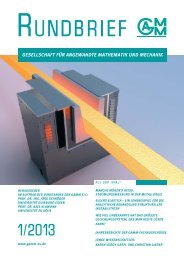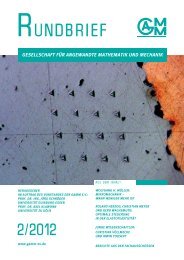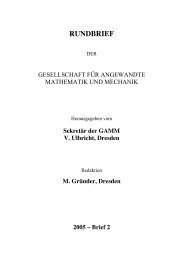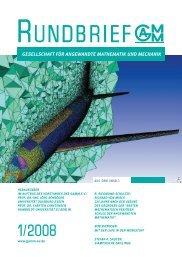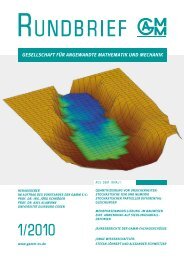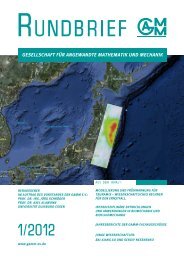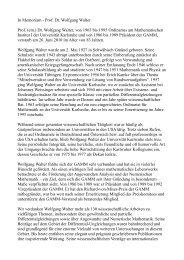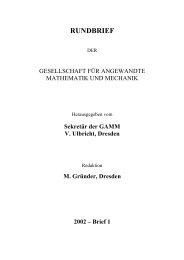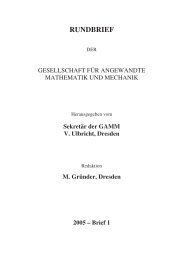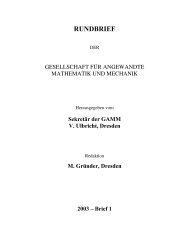GAMM Rundbrief 2002/Heft 2
GAMM Rundbrief 2002/Heft 2
GAMM Rundbrief 2002/Heft 2
Create successful ePaper yourself
Turn your PDF publications into a flip-book with our unique Google optimized e-Paper software.
Wissenschaftliche Tagungen 85<br />
Methodological challenges<br />
In recent years, extremely powerful numerical methods have been developed for<br />
solving complex direct problems, e.g., multi-field problems in three dimension, both<br />
static and dynamic. Such methods include multigrid or, more general, multi-level<br />
methods and domain decomposition. When solving inverse problems for such complex<br />
problems, new questions arise also for the numerical treatment of the inverse problem,<br />
which include the optimal coupling of regularization methods with direct solvers in<br />
order to achieve overall optimal performance<br />
A powerful numerical method whose main advantage is that it can easily handle<br />
changes in the topology is the level set method. It has recently also been applied to<br />
inverse problems.<br />
Over the years, two major approaches have been followed in the inverse problems<br />
community: statistical and functional-analysis based approaches. A full understanding<br />
of the relations between these approaches is still lacking; this is also important for the<br />
issue of "uncertainty".<br />
During the proposed Special Semester, special emphasis will be laid on some of these<br />
and other emerging challenges, although more classical topics will not be neglected.<br />
The Special Semester is intended to bring together scientists and engineers with applied<br />
and pure mathematicians interested in inverse problems.<br />
The Special Semester will be structured as follows<br />
Tutorials: In the second (and maybe also third) week of September 2003, a series of<br />
tutorials will be held both on methodological and on applications issues of inverse<br />
problems. These should also set the stage for research collaborations between<br />
mathematicians and applications scientists that should go on throughout the semester,<br />
and should prepare the participants for the subsequent events. The final list of topics<br />
has not yet been decided, a tentative list is:<br />
Methodology: regularization methods for inverse problems inverse spectral problems<br />
statistical and wavelet methods for inverse problems level set methods.<br />
Application fields inverse problems in the physical sciences, grouped according to<br />
different application fields inverse problems in imaging science inverse problems in<br />
biology inverse scattering and tomography.<br />
Study group with industry: This format has probably the longest tradition in Oxford<br />
and has been implemented also in other European countries, in Australia, and at RPI.<br />
On the first day of such a study group, industrial researchers present problems for<br />
which they want a mathematical model, solution, algorithm. In the following days, open<br />
discussions in groups, which tend to be quite intensive, should lead to progress. The<br />
outcome will generally not be a final solution, but a first mathematical model and a<br />
clear plan for further work. Such a study group should focus on problems from West<br />
Coast industries (but not exclusively) in order to make a follow-up by inverse problems<br />
experts who visit IPAM for the semester possible. Topics where industrial contacts<br />
have already been made include inverse problems and optimal design in photonics and<br />
inverse problems in finance, especially identification of volatilities and interest rate<br />
models.



